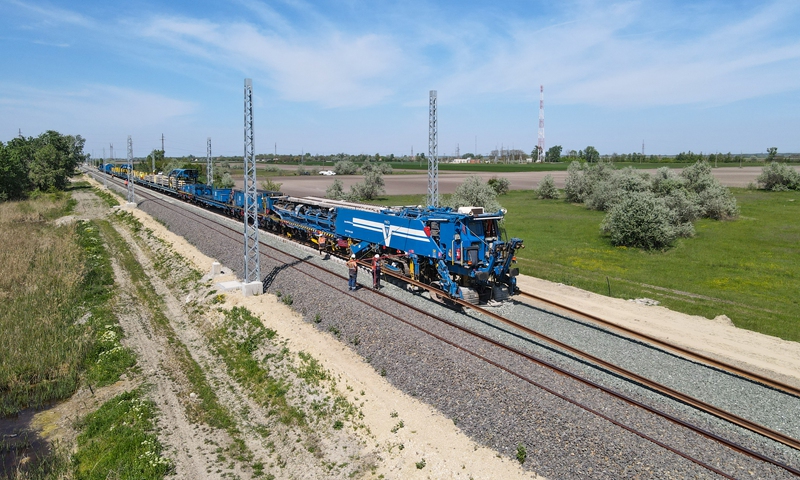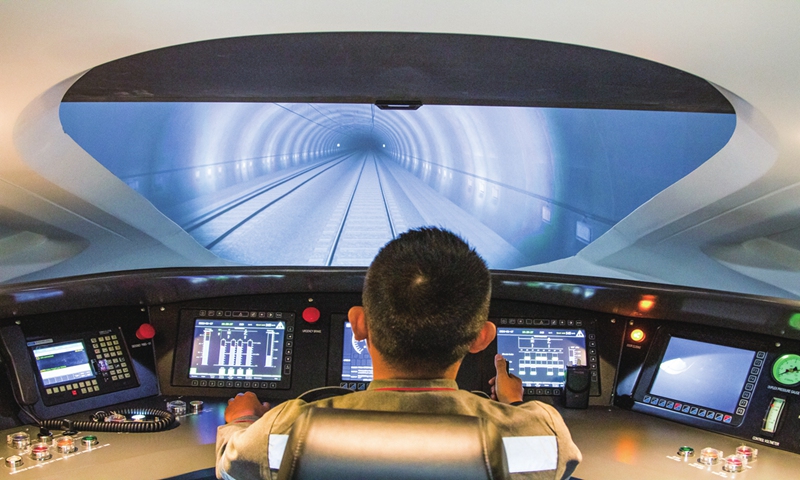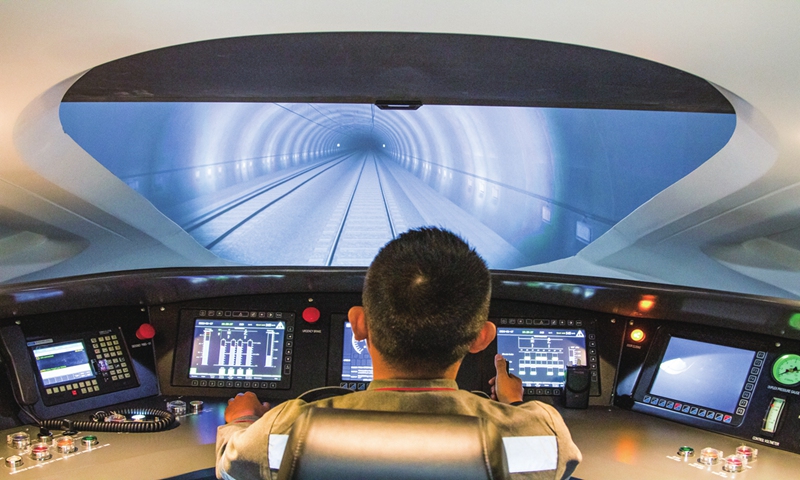
The Hungarian section of the Hungary-Serbia railway is under track-laying construction. Photo: Courtesy of the Hungarian branch of CREC
A track-laying machine made a rumbling sound as concrete sleepers are placed on the roadbed. Two-hundred-meter-long rails extend and fall steadily onto the sleepers through a mix of manual labor and high-tech machinery.
This has become a common scene during track-laying construction on the Hungarian section of the Hungary-Serbia railway, the flagship cooperative project under China-proposed Belt and Road Initiative (BRI). Here, extended railway lines are connecting scattered cities into an accessible and dynamic network, linking Hungary and Serbia, two Central and Eastern European (CEE) countries ever closer together.
Engaged in a wide range of fields such as transportation, high-end manufacturing and mining, Chinese companies have been actively promoting economic development in the regional countries. The companies bring with them advanced technology, high-tech equipment, modern management concept, and integrate them to better meet local development needs, contributing to the economic growth and improvement of the people’s livelihood there.
As the BRI now enters its second golden decade, this week’s state visits by China’s top leader chart the course for cooperation between China and the two CEE countries in their respective pursuit of high-quality development.
A number of Chinese companies rooted in Serbia and Hungary for many years have recently shared with the Global Times how they have achieved win-win cooperation and development under the BRI framework. The companies are looking forward to embracing new opportunities for high-quality development in the two countries.
Promotion of synergy
Along a section of the Hungary-Serbia railway in Hungary, which is been built by a Chinese company, track laying work is progressing smoothly. Since the job officially commenced at the end of May last year, about 70 percent of track laying work within the section has been completed, with the overall project completion rate exceeding 55 percent, the Global Times learned.
By the time of its completion, the regional transportation network will be significantly improved, providing greater convenience for both passengers and cargo delivery across the CEE economies.
The Hungary-Serbia railway could well illustrate how China’s BRI projects can help promote the regional economic synergy.
At a heavy equipment manufacturing plant in Ruma, Serbia, excavators and haulage vehicles were seen navigate through the site, accompanied by the rhythmic sounds of welding, cutting, and hammering. Amid this activity, workers diligently carry out tasks such as reinforcing steel bars and pouring foundation concrete, ensuring an organized and efficient work flow.
China Construction First Group has participated in the construction of the new factory project. With a keen focus on meeting the deadline, they aim to complete the prefabricated components during the second half of 2024. Once finished, this facility, owned by the Chinese company Haitian Group, will serve as a pivotal manufacturing hub for equipment like injection molding machines in the European region, the Global Times learned from China Construction First Group.
Chen Shuai, deputy general manager of the Fifth Construction Co, China Construction First Group, told the Global Times that the company is seizing the opportunity presented by the successful execution of the factory project in Serbia, to facilitate the expansion of China’s industrial manufacturing capacity overseas.
As the bilateral strategic partnership relations deepen, Chen holds strong expectations for further tapping into the potential for deeper cooperation for Chinese companies in Serbia.
Specifically, they will ramp up efforts to capitalize on the burgeoning development of infrastructure in Serbia, participating in projects spanning roads, bridges, tunnels, and renewable energy production, among other industrial lines, Chen said.
Serbia Zijin Copper DOO in Bor, Serbia, a joint venture between China’s Zijin Mining Group and Serbia, sets a good example of how the BRI prompts greater synergy in the regional development. By the end of 2023, the copper mine project in Bor had amassed investments totaling $2.498 billion, nearly double the promised investment of $1.26 billion in 2018, the company told the Global Times.
With a cumulative copper production of 356,000 tons and gold production of 9.8 tons, the project contributed nearly $500 million in taxes and fees and made a social contribution of $850 million, according to the company. Also, it created over 9,000 jobs. In 2023, the company achieved export revenues of around $720 million, significantly promoting the mutual development of stakeholders in Serbia.
Looking ahead, the company plans to add $1.2 billion in new investments in the next three years. The goal is to increase copper production of the copper mine in Bor from currently 120,000 tons per year to 220,000 tons per year by 2030, the company said.
High-quality growth
As the BRI embarks on its new journey after10 years of golden development, more possibilities will emerge in the cooperation between China and the regional countries.
The meetings between the top leaders of China and the regional countries this week have set the tone for deepening the bilateral ties while pushing the cooperation toward high-quality development.
In the joint statement signed on Wednesday between China and Serbia, both sides vowed to take the opportunity of entering a new stage of high-quality development in the joint construction of the BRI. They aim to deepen and expand cooperation in various fields, including trade, investment, technology innovation, digitalization, and telecommunications.
Meanwhile, China and Hungary are also expected to sign multiple cooperation agreements following the important meetings between leaders of the two countries, injecting new momentum into the development of bilateral relations.
In a recent interview with the Global Times, Chinese Ambassador to Hungary Gong Tao said that, in the future, both sides will continue to promote high-quality joint construction of the BRI, focusing on key areas such as digital economy, green development, and information technology.
During recent years, China has actively promoted cooperation with the CEE countries under the BRI. This initiative has yielded tangible benefits for the region, effectively enhancing connectivity between China, Eastern Europe, and the broader European region, Song Wei, a professor from the School of International Relations at Beijing Foreign Studies University, told the Global Times on Thursday, describing China-CEE cooperation as a role model for cross-regional collaboration.
Despite the marked progress, economic development in CEE is still encountering some challenges, including poverty reduction, and how to achieve faster economic modernization in the region, according to Song.
Song emphasized that amid the pursuit of high-quality cooperation and partnership, China will remain committed to further supporting CEE countries in integrating them into the global value chain.
Specifically, Song said that enhancing mutual investment programs, including on setting up joint investment funds, would incentivize more local enterprises in CEE to participate in the BRI.
The countries in the region are eager to draw from China’s successful developmental experiences. Therefore, both sides may intensify efforts to collaborate on a series of training programs and exchanges, facilitating mutual learning and development in the future, Song said.
“The commitment aims to foster closer economic and trade ties between China and the CEE economies, assisting the region to better tackle its corresponding challenges in the future,” Song said.


